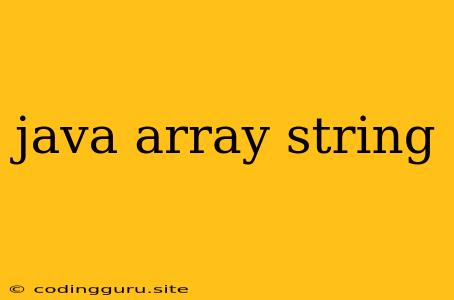Working with Java String Arrays: A Comprehensive Guide
Java arrays are a fundamental data structure, and understanding how to work with them is crucial for any Java developer. String arrays, specifically, are versatile and commonly used for storing and manipulating collections of text data.
This guide will equip you with the knowledge and skills necessary to confidently work with Java string arrays. We will delve into various aspects of their usage, including creation, initialization, manipulation, and traversal.
Creating a Java String Array
To create a string array in Java, you use the following syntax:
String[] myStringArray = new String[size];
String[]: This declares the variable as a string array.myStringArray: This is the name you choose for your array.new String[size]: This creates an array with the specifiedsizenumber of elements.
Example:
String[] colors = new String[3];
This creates an array called colors that can hold 3 strings. Remember, the array is initially filled with null values.
Initializing a Java String Array
You have two primary ways to initialize a string array:
1. Direct Initialization:
This method assigns values to each element during the array's creation.
String[] days = {"Monday", "Tuesday", "Wednesday", "Thursday", "Friday", "Saturday", "Sunday"};
2. Individual Initialization:
This approach initializes each element separately after array creation.
String[] fruits = new String[4];
fruits[0] = "Apple";
fruits[1] = "Banana";
fruits[2] = "Orange";
fruits[3] = "Mango";
Accessing Elements in a Java String Array
To access an element in a string array, use its index, which starts from 0.
Example:
String[] animals = {"Cat", "Dog", "Bird"};
String firstAnimal = animals[0]; // Accessing the first element
System.out.println(firstAnimal); // Output: Cat
Manipulating Java String Arrays
You can manipulate string arrays using various methods:
1. Modifying Array Elements:
String[] names = {"Alice", "Bob"};
names[1] = "Charlie"; // Replacing the second element
2. Looping Through an Array:
You can use a for loop to iterate through the array and access or modify its elements.
String[] hobbies = {"Reading", "Coding", "Traveling"};
for (int i = 0; i < hobbies.length; i++) {
System.out.println(hobbies[i]);
}
This loop prints each hobby in the hobbies array.
3. Finding the Length of an Array:
Use the length property to get the number of elements in the array.
String[] cities = {"New York", "London", "Tokyo"};
int size = cities.length; // size will be 3
Other String Array Operations
1. Sorting an Array:
You can sort the elements in a string array alphabetically using Arrays.sort().
String[] countries = {"Canada", "Brazil", "India"};
Arrays.sort(countries); // Sorts the array
for (String country : countries) {
System.out.println(country);
}
2. Searching in an Array:
The Arrays.binarySearch() method allows you to find the index of a specific element within a sorted array.
String[] books = {"The Hitchhiker's Guide to the Galaxy", "Pride and Prejudice", "To Kill a Mockingbird"};
Arrays.sort(books); // Sort the array
int index = Arrays.binarySearch(books, "To Kill a Mockingbird");
System.out.println(index); // Output: 2 (if found, otherwise negative value)
3. Converting to String:
You can convert a string array into a single string using Arrays.toString().
String[] fruits = {"Apple", "Banana", "Orange"};
String fruitString = Arrays.toString(fruits); // Output: "[Apple, Banana, Orange]"
Common Mistakes and Considerations
- ArrayIndexOutOfBoundsException: This error occurs when you attempt to access an element outside the valid index range. For an array of size
n, valid indices are from 0 ton-1. - NullPointerException: If an array element is
null, attempting to use it without checking can lead to aNullPointerException. - Dynamic Arrays: Java string arrays are fixed-size, so if you need to add or remove elements dynamically, consider using a
List(likeArrayList) instead.
Conclusion
Understanding how to work with Java string arrays is crucial for handling and processing text data effectively. This comprehensive guide has covered essential aspects of string array creation, initialization, manipulation, and common operations. By mastering these concepts, you can confidently utilize string arrays in your Java programs to solve a wide range of problems.
